prison
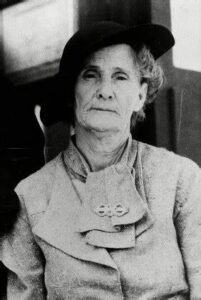
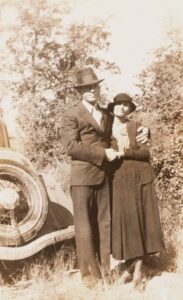 As sometimes happens, children grow up and start hanging out with the wrong crowd. Soon they are in trouble, and it falls to their parents to get them back on the right track. So, what if their parents got them on the wrong track in the first place? Such, it seems was the case with Clyde Barrow and Bonnie Parker, better known as Bonnie and Clyde. No one really knew about the inner workings of Bonnie and Clyde’s gang of thugs. Still, the evidence was mounting, even if the payoffs to the police kept most of that information from getting to the people who needed it.
As sometimes happens, children grow up and start hanging out with the wrong crowd. Soon they are in trouble, and it falls to their parents to get them back on the right track. So, what if their parents got them on the wrong track in the first place? Such, it seems was the case with Clyde Barrow and Bonnie Parker, better known as Bonnie and Clyde. No one really knew about the inner workings of Bonnie and Clyde’s gang of thugs. Still, the evidence was mounting, even if the payoffs to the police kept most of that information from getting to the people who needed it.
After Bonnie and Clyde, as well as Clyde’s brother Marvin “Buck” Barrow were killed, the US Government began their investigation against most of the Barrow clan, including Clyde Barrow’s mom, Cumie Barrow. In all, more than a dozen family members were put on trial. Strangely, Clyde Barrow’s dad, Henry was not among then. The main focus was on Clyde’s mom, Cumie Barrow. During his closing argument, US attorney for the Northern District of Texas, Clyde O Eastus made a surprising allegation. Pointing at Clyde’s mother, Cumie Barrow, Eastus roared: “She is the ringleader in this conspiracy!” Of course, he was right. I find it odd that she had been given a Hebrew name. If you recall, during one of His miracles, Jesus said to a young girl who had died, “Talitha Cumi” which means “Young girl, arise.” Cumie’s parents turned it around a little and changed the spelling of Cumi to Cumie, but the meaning is still there, just translated “Arise, young girl.” Ironically, Cumie did arise, but it was not to do good, nor was it in any way miraculous, but rather pure evil.
Eastus was probably embellishing his point for the Dallas jury a little bit, by putting Cumie front and center, but he did so because she admitted meeting regularly with the fugitives and was known to provide them with food, clothing and other comforts. Still, when we look back on Bonnie and Clyde’s history, the claims made by Eastus were likely spot on. Cumie was in this a deep as anyone, and especially as deep as Bonnie and Clyde. Reports indicate that Henry and Cumie always lived modestly in their little house, running their service station, and for all intents and purposes not possessing any large amounts of money. It is said that Bonnie and Buck’s wife, Blanche gave some money to their mothers, but the bulk of the money the men stole went to Cumie, to be managed and doled out as needed. It mostly went to the boys and their partners, and to the police, judges, and anyone else that Cumie needed to buy off to save her sons from going to jail. Cumie truly was the woman behind Clyde Barrow.
The police and judges in that era were often under paid and under trained, so it was much easier to bribe them, and Cumie would do whatever it took. Cumie worked very hard to paint herself as the loving mother, who was just looking out for her sone. She was almost certainly more complicit than that. Cumie Walker was born near Swift, Texas, in 1874. She married Henry Barrow just after she turned 17. She was far more literate than her husband, who had been sickly and never went to school. The couple started farming, but they were unsuccessful. As their family grew, Cumie became savvy in survival skills. In 1922 they moved to Dallas and Henry began peddling scrap.
In early 1930, he met and fell head over heels for Bonnie Parker, an animated, petite blond who was separated from her teen husband. Just a few weeks later, though, Clyde was arrested and eventually sent to Waco, Texas, where he was quickly tried and convicted for several thefts and burglaries. Authorities in Houston then blamed him for a murder several months before. With Clyde facing 14 years in prison and a murder charge, Cumie gave an interview to the Waco News-Tribune, insisting he was in Dallas, not Houston at the time of the murder. She attributed his troubles to falling in with a bad group of young men and noted, correctly, that he had previously been charged, but never convicted, of a crime. She also told a whopper: “Clyde was just 18 last Monday.” In reality, he was at least two years older than that. Nevertheless, she knew that the state tended to be more lenient with teens, so she did what she had to do. The reality is that he was likely 21.
The murder charge was dropped when another suspect emerged. But when Clyde arrived at the state penitentiary to serve his sentence, he listed his age as 18. Then Cumie told an even bigger lie. She said that her son was needed at home, because she was widowed, and he was needed to help provide for the family. She and Henry had moved their tiny hand-built house to a West Dallas lot where Henry ran a modest filling station from a front room. Henry Barrow was very much alive.
The corruption in those days was definitely cringeworthy. Either Cumie or her lawyers also collected recommendation letters from the sheriff who held Clyde in the Waco jail, the judge who sentenced him, and other officials who supported his release. He should never have been released, and the people he murdered after being released might have lived full lives, had he not been released. Nevertheless, the state pardon board concurred, recommending his parole because “Barrow was only 18 years old when he got into his trouble,” and he would go home to “support and care for” his mother. Of course, Clyde did support his mother, but not by honest means. Within a year, he was linked to at least four murders, some kidnappings, and all kinds of robberies. Still, his mother was quick to defend him, portraying him as “a kind son who came by the gas station just after Christmas to give her a hug and kiss.” She worried aloud that “We may hear any minute that he’s dead.” She claimed that she asked him if he had killed anyone, and he promptly told her, “Mother, I haven’t never done anything as bad as kill a man.” She insisted, “Everybody likes Clyde, you know,” sharing some family photos of her son. Looking at one of them, she sobbed. “Clyde…isn’t a… murderer.”
By July 1933, her son Buck was dying from injuries suffered in two shootouts, including a bullet to his head. Cumie was devastated. She immediately drove with several family members to Iowa. Again, she stood by Clyde, refusing to urge him to turn himself in. She knew that if he surrendered, he would almost certainly be executed. She said, and if he didn’t surrender, officers would likely shoot to kill. “So, I’m going to let him live his last few days the way he wants to.” Bonnie and Clyde were killed on May 23, 1934.
In an early 1935 trial, after closing arguments, the all-male jury found everyone guilty. Even though prosecutor Eastus had condemned Cumie Barrow, the lenient Judge William Atwell struggled to sentence her. Her influence still held firm. Finally, he said, “Perhaps sixty days in jail will suffice.” Then, he asked Cumie, “What do you think of the sentence? Is it fair?” Her eyes red from crying, Cumie looked at him, her hands clasped together. S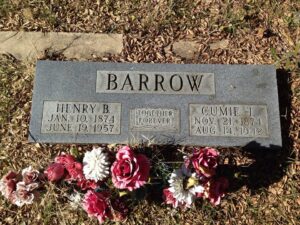
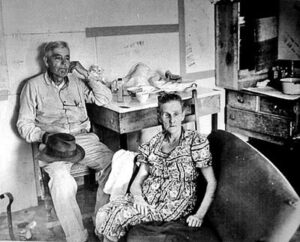 he implored, “Judge, won’t thirty days be long enough? I am needed at home.” And in true corruption style, the judge said, “Thirty days in jail.” Cumie died August 14, 1942, at home, after being sick for three or four weeks. She was 67 years old. Of her seven children, Buck and Clyde were dead, two daughters who lived in Dallas had no police records, and the other three were in prison. What a hideous legacy she left.
he implored, “Judge, won’t thirty days be long enough? I am needed at home.” And in true corruption style, the judge said, “Thirty days in jail.” Cumie died August 14, 1942, at home, after being sick for three or four weeks. She was 67 years old. Of her seven children, Buck and Clyde were dead, two daughters who lived in Dallas had no police records, and the other three were in prison. What a hideous legacy she left.
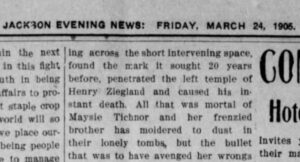 I think every one of us has been the victim of a hoax. Hoaxes are like a joke…a bad joke. In reality, a hoax is a cruel scheme designed to pull one over on their intended victim. One such hoax was the story of “The Patient Bullet.” As the story goes, a man named Henry Ziegland dumped his fiancé, Maysie Tichnor, in 1883 in the town of Honey Grove, Texas. So upset was Tichnor, that she actually committed suicide. Her brother was distraught and enraged, so he decided that Ziegland had to die in retaliation. He immediately went to Ziegland’s farm and shot the young man who had hurt his sister, then so as not to face prison, he turned the gun on himself.
I think every one of us has been the victim of a hoax. Hoaxes are like a joke…a bad joke. In reality, a hoax is a cruel scheme designed to pull one over on their intended victim. One such hoax was the story of “The Patient Bullet.” As the story goes, a man named Henry Ziegland dumped his fiancé, Maysie Tichnor, in 1883 in the town of Honey Grove, Texas. So upset was Tichnor, that she actually committed suicide. Her brother was distraught and enraged, so he decided that Ziegland had to die in retaliation. He immediately went to Ziegland’s farm and shot the young man who had hurt his sister, then so as not to face prison, he turned the gun on himself.
The brother died by suicide, but Ziegland did not die. In fact, somehow, he had even escaped serious injury. The bullet had only grazed him before hitting a tree. In what seemed a gross miscarriage of justice, Ziegland went on to live a prosperous life and had a family. Then, twenty years after he literally dodged a bullet, Ziegland and his son were cutting firewood. It so happened that they cut down the tree with the bullet in it. The wood in that tree was so tough that it was almost impossible to split it with an 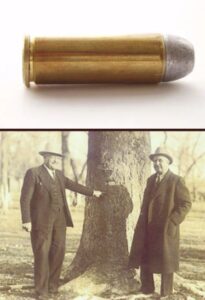 axe. Ziegland decided to bore some holes in the fallen tree and put small amounts of dynamite in the holes. After moving about 50 feet away, Ziegland and his son set the explosions off. Shockingly, the bullet, which had waited twenty years for Henry Ziegland, was blown out of the tree with great force and the farmer was hit in the left temple and killed instantly…so the story goes anyway.
axe. Ziegland decided to bore some holes in the fallen tree and put small amounts of dynamite in the holes. After moving about 50 feet away, Ziegland and his son set the explosions off. Shockingly, the bullet, which had waited twenty years for Henry Ziegland, was blown out of the tree with great force and the farmer was hit in the left temple and killed instantly…so the story goes anyway.
Some hoaxes are pretty easy to figure out, but others, like the Ziegland story, sort of seemed plausible. Because of that, The Patient Bullet story was fairly popular. It was posted all over the Internet, complete with a picture of the bullet and the tree. The story appeared over 100 times in the newspapers, where it was presented as legitimate news. Nevertheless, there is quite a bit of evidence to suggest the story of Henry Ziegland was a hoax. In reality, there is no record of anyone with the names Ziegland or Tichnor or anything similar that ever lived in Honey Grove. In fact, a thorough search shows no vital records for people who match these dates and descriptions in Texas or any other state, for that matter.
The story was first appeared in the Jackson Mississippi Evening News in March 24, 1905. The tale was interesting, and it took off like wildfire. It was picked up by several papers, and began, “A marvelous case of punishment on earth for the sins of the flesh occurred in Dryno township, in this county, today. Twenty years ago Henry Ziegland, then a handsome, wealthy young man, jilted beautiful Maysie Tichnor, and the girl committed suicide…” After that the story disappeared for the better part of the decade, before it inexplicably 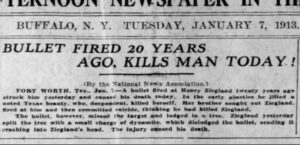 reappeared in 1913. The names were the same, but the newspapers still ran the story as current news. This time, the story’s fame grew. It ran in newspapers from Edmonton (Canada) to New Orleans to Buffalo. It’s almost a comical situation, because it was probably started by a couple of teenagers sitting around in 1905, who came up with this funny little story and decided to see if they could trick a newspaper into publishing it. Well, not only were they able to get it published, but by 1913, it was appearing in international newspapers. Now, over a century later, the story is still viewed as truth. In fact, a Google search for “Henry Ziegland bullet” produces over 5,400 results!
reappeared in 1913. The names were the same, but the newspapers still ran the story as current news. This time, the story’s fame grew. It ran in newspapers from Edmonton (Canada) to New Orleans to Buffalo. It’s almost a comical situation, because it was probably started by a couple of teenagers sitting around in 1905, who came up with this funny little story and decided to see if they could trick a newspaper into publishing it. Well, not only were they able to get it published, but by 1913, it was appearing in international newspapers. Now, over a century later, the story is still viewed as truth. In fact, a Google search for “Henry Ziegland bullet” produces over 5,400 results!

 For people who live in Casper, Wyoming, the mountain to the south has long been a great recreation area. They are campgrounds and a ski resort, not to mention the trails that dot the mountain top. While the mountain is mostly recreational today, along with a number of people who live on the mountain full-time, that wasn’t always the case. In 1890, a gold strike on Casper Mountain brought a little gold rush to the area…along with many different kinds of people, looking to strike it rich. The mountain was crawling with people from all walks of life, but while they looked until 1895, they didn’t find much gold. The materials found were mostly asbestos and other non-profitable minerals.
For people who live in Casper, Wyoming, the mountain to the south has long been a great recreation area. They are campgrounds and a ski resort, not to mention the trails that dot the mountain top. While the mountain is mostly recreational today, along with a number of people who live on the mountain full-time, that wasn’t always the case. In 1890, a gold strike on Casper Mountain brought a little gold rush to the area…along with many different kinds of people, looking to strike it rich. The mountain was crawling with people from all walks of life, but while they looked until 1895, they didn’t find much gold. The materials found were mostly asbestos and other non-profitable minerals.
Nevertheless, there arose a need for a town and supply stores, so the town of Eadsville was formed. It was located 12 miles due south of Casper on top of Casper Mountain. It was founded by Charles W Eads in 1891 after he had staked a 600-foot x 1,500-foot mining claim around a large spring. The town was named for one Charles W Eads, who was the second person to settle in Casper, following a Mr. Merritt, who was credited with being the first to locate to Casper. Eads appeared in the Natrona County Tribune, May 13, 1908, and was apparently accused of being a horse thief. He would go on to do time in prison.
It was thought that there were large deposits of precious minerals, such as gold, silver, lead, and copper. The town continued to develop, with lots being sold in the town during 1891 – 1892. During that time, about a dozen cabins were built. While the town became a ghost town before very long, the foundations of three cabins still remain today. During the boom years, some 40 to 50 people lived there, all hoping to make their millions in gold and silver. Some traces of gold and silver were found, and copper was also mined, but asbestos and feldspar were the most economical to mined. The “spar” was still being mined after nearly 100 years. It’s no longer being mined, but it could be again, if there was a need.
After a time of trying unsuccessfully to make a living, the miners finally gave up and abandoned the town 
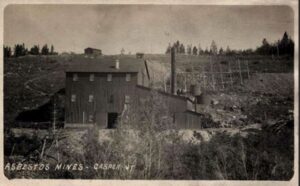 between 1905 and 1906. The site was rediscovered in the 1980s, and numerous artifacts were uncovered during an archeological excavation that was conducted between 1983 and 1985. At one time it was surveyed as a stamp mill. Eadsville was located on Casper Mountain at an elevation of 7,800 feet and covered an area 20 acres.
between 1905 and 1906. The site was rediscovered in the 1980s, and numerous artifacts were uncovered during an archeological excavation that was conducted between 1983 and 1985. At one time it was surveyed as a stamp mill. Eadsville was located on Casper Mountain at an elevation of 7,800 feet and covered an area 20 acres.
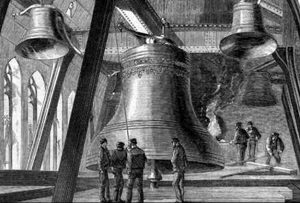 When you think of Big Ben, many of us think of a tower in London…or at least I did. The reality is that Big Ben isn’t the tower at all…it’s the bell. The tower is actually called the Elizabeth Tower…at least since 2012 when it was renamed that in honor of the current Queen Elizabeth. Prior to 2012, the tower was just called “the clock tower.” That was it’s official name, but it was nicknamed Saint Stephen’s tower. It’s funny that we can associate a specific name or idea to something, and have the whole thing totally wrong. The tower name is an interesting story, but that is not the only oddity when it comes to Big Ben.
When you think of Big Ben, many of us think of a tower in London…or at least I did. The reality is that Big Ben isn’t the tower at all…it’s the bell. The tower is actually called the Elizabeth Tower…at least since 2012 when it was renamed that in honor of the current Queen Elizabeth. Prior to 2012, the tower was just called “the clock tower.” That was it’s official name, but it was nicknamed Saint Stephen’s tower. It’s funny that we can associate a specific name or idea to something, and have the whole thing totally wrong. The tower name is an interesting story, but that is not the only oddity when it comes to Big Ben.
As interesting as that was to me, I find it even more interesting to find out that there is actually a prison in the tower. A third of the way, or 114 steps up inside the tower is the Prison Room, where MPs in breach of codes of conduct were imprisoned. The prison room was last used in 1880 when  newly elected MP Charles Bradlaugh, who was an atheist, refused to swear allegiance to Queen Victoria on the Bible. He was kept in the prison room overnight. These days there is a pub named after him in Northampton. I’m not sure how many more people were imprisoned there, but it is certainly a strange use for a clock tower.
newly elected MP Charles Bradlaugh, who was an atheist, refused to swear allegiance to Queen Victoria on the Bible. He was kept in the prison room overnight. These days there is a pub named after him in Northampton. I’m not sure how many more people were imprisoned there, but it is certainly a strange use for a clock tower.
There are 334 steps over 11 floors up to the belfry…399 up to the lantern of the Elizabeth Tower. Each clock face measures 23 feet in diameter. The minute hand on each clock face is 14 feet long, and the hour hand is 9 feet long. The main bell weighs 13.7 tons and is 9 feet in diameter. There are four quarter bells that are smaller. These have different dimensions to enable them to hit different notes. At the top of the tower is an extra light called the Ayrton Light. It was installed so Queen Victoria could see when the members of parliament were sitting after hours.
The current bell is not the original bell. The original bell was famously cast at Whitechapel Bell Foundry. The contract to create the bell went to a company called Warners of Norton in Stockton-on-Tees. A 16.5 ton bell was created and delivered to London before the clock tower was ready. For several months, the bell was tested outside the tower. It was working fine until the man who designed it, Edmund Beckett Denison, decided he  wanted it louder so added a much larger hammer. Three weeks later the bell broke. It was sent to Whitechapel Bell Foundry in pieces and melted down to create the new 13.5 ton bell. Once complete, it took 32 hours to winch it up the tower. Just two months after the bell named Big Ben first went into service in 1859, it was cracked. The hammer that was installed to ring the bell was roughly twice the size it should have been for a bell of that size. Nevertheless, the damage was done. The bell remains flawed to this day. A lighter hammer was fitted, and the bell was rotated slightly so that the hammer no longer hits the cracked section. The clock uses penny weights to keep the time accurate.
wanted it louder so added a much larger hammer. Three weeks later the bell broke. It was sent to Whitechapel Bell Foundry in pieces and melted down to create the new 13.5 ton bell. Once complete, it took 32 hours to winch it up the tower. Just two months after the bell named Big Ben first went into service in 1859, it was cracked. The hammer that was installed to ring the bell was roughly twice the size it should have been for a bell of that size. Nevertheless, the damage was done. The bell remains flawed to this day. A lighter hammer was fitted, and the bell was rotated slightly so that the hammer no longer hits the cracked section. The clock uses penny weights to keep the time accurate.
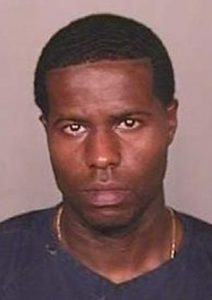 Prisoners have tried to escape ever since there have been prisons. It is the nature of the situation. No one likes to be locked up. Most escape attempts are not successful, and few are what we would consider well planned, but in the case of Florida prison inmates, Charles Walker and Joseph Jenkins, some kind of good planning must have gone into the escape plan. The two men were serving life sentences, without the possibility of parole, for murder, and so I guess they had nothing to lose by getting caught in an escape attempt. Jenkins was incarcerated for a 1998 murder and armed robbery and a 1997 auto theft. He has been in prison since 2000. Walker was imprisoned for a 1999 murder and has been in custody since 2001.
Prisoners have tried to escape ever since there have been prisons. It is the nature of the situation. No one likes to be locked up. Most escape attempts are not successful, and few are what we would consider well planned, but in the case of Florida prison inmates, Charles Walker and Joseph Jenkins, some kind of good planning must have gone into the escape plan. The two men were serving life sentences, without the possibility of parole, for murder, and so I guess they had nothing to lose by getting caught in an escape attempt. Jenkins was incarcerated for a 1998 murder and armed robbery and a 1997 auto theft. He has been in prison since 2000. Walker was imprisoned for a 1999 murder and has been in custody since 2001.
The men were serving their time in a Panhandle prison called Franklin Correctional Institution in Carrabelle, Florida. accidentally released two inmates from a Panhandle prison who are convicted murderers, according to published reports. Somehow, Walker and Jenkins, both 34, were able to obtain fraudulent orders of sentence modification. Based on those modifications, Jenkins was released on September 27, 2013, and Walker was released on October 8, 2013. Both were former residents of Orlando. Their release was apparently “in accordance with Department of Corrections policy and procedure. However, both of their releases were based on fraudulent modifications that had been made to court orders,” Department of Corrections secretary Michael Crews said.
The judge whose name is on the forged documents is Belvin Perry, Orange County chief judge, who presided 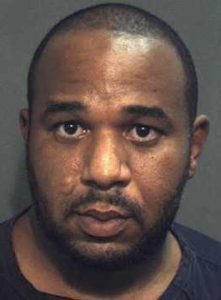 over the Casey Anthony case. Perry’s office said that the judge’s signature was forged in the paperwork calling for reduced sentences for the convicted killers. Apparently, however, while the false documents had problems the one thing that was correct was the judges signature. The judge denies any wrongdoing, saying “It is quite evident that someone forged a court document, filed a motion, and that someone with the aid of a computer, lifted my signature off previous signed documents, which are public reports, affixed that to the document, sent it to the clerk’s office. It was processed and forwarded to doc and the defendant ended up being released,” Perry maintains. He also says, “I have never seen anything like this. You have to give them an A for being imaginative and effective.” The reality is that this was not the first time a prisoner managed to obtain false documents, and probably wont be the last, since no one was caught in this act. The prison waited 17 days before notifying the authorities of the escape. Cybercrime is the newest thing. Easy to perform, hard to catch.
over the Casey Anthony case. Perry’s office said that the judge’s signature was forged in the paperwork calling for reduced sentences for the convicted killers. Apparently, however, while the false documents had problems the one thing that was correct was the judges signature. The judge denies any wrongdoing, saying “It is quite evident that someone forged a court document, filed a motion, and that someone with the aid of a computer, lifted my signature off previous signed documents, which are public reports, affixed that to the document, sent it to the clerk’s office. It was processed and forwarded to doc and the defendant ended up being released,” Perry maintains. He also says, “I have never seen anything like this. You have to give them an A for being imaginative and effective.” The reality is that this was not the first time a prisoner managed to obtain false documents, and probably wont be the last, since no one was caught in this act. The prison waited 17 days before notifying the authorities of the escape. Cybercrime is the newest thing. Easy to perform, hard to catch.
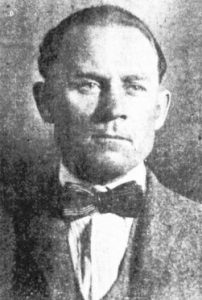 The Spencer ancestry is riddled with names that have been passed down from generation to generation. So much so, in fact, that it can get confusing when researching one’s ancestry. Common names are William, Robert, Thomas, John, Allen, and Christopher. My dad’s family was no different than any other of the Spencer families. The boys in the family were William, named after his grandfather, William, who had a great grandfather named William, and many more I’m sure. My dad was Allen, who was named after his dad Allen, who was named after his grandfather Allen. And many of the children also used those same names, so there were cousins named William and Allen too. Most of the time it only created problems with the ancestry, mail, school things, and such, but when a man named Ethan Allen Spencer (relation, I’m sure, but just how I don’t know) decided that he needed a little bit of excitement in his life, he decided to go from a law-abiding farm family background to becoming a bank and train robber. Ethan Allen “Al” Spencer was born the day after Christmas in 1887 near Lenepah in Nowata County. He came from a law-abiding farm family. He married and soon was the father of a baby girl. So, why would he abandon all that to become a criminal.
The Spencer ancestry is riddled with names that have been passed down from generation to generation. So much so, in fact, that it can get confusing when researching one’s ancestry. Common names are William, Robert, Thomas, John, Allen, and Christopher. My dad’s family was no different than any other of the Spencer families. The boys in the family were William, named after his grandfather, William, who had a great grandfather named William, and many more I’m sure. My dad was Allen, who was named after his dad Allen, who was named after his grandfather Allen. And many of the children also used those same names, so there were cousins named William and Allen too. Most of the time it only created problems with the ancestry, mail, school things, and such, but when a man named Ethan Allen Spencer (relation, I’m sure, but just how I don’t know) decided that he needed a little bit of excitement in his life, he decided to go from a law-abiding farm family background to becoming a bank and train robber. Ethan Allen “Al” Spencer was born the day after Christmas in 1887 near Lenepah in Nowata County. He came from a law-abiding farm family. He married and soon was the father of a baby girl. So, why would he abandon all that to become a criminal.
“Al” Spencer became a criminal as the era of horseback riding was coming to an end, and modern motorized criminals were just getting started. That fact, made Spencer an almost forgotten outlaw. Spencer began his career in crime by getting caught stealing cattle in his early 30s. Then in 1919, he and two men burglarized a clothing store in Neodesha, Kansas. Detectives recovered most of the stolen property and arrested Spencer in La Junta, Colorado. The Kansas court convicted and sentenced him to five years in prison. Then the Oklahoma authorities gained custody of Spencer so they could try him on charges of cattle theft. Spencer pleaded guilty and was sentenced to three to 10 years in the Oklahoma penitentiary at McAlester. He began serving his sentence in March 1920. If you ask me, he should have stuck to farming, because he wasn’t very good at crime. Spencer became friends with another convict named Henry Wells and learned a great deal about crime…becoming better, I suppose…at least as long has Wells was with him. In the 1920s, it was not unusual for Oklahoma governors to grant convicts a leave of absence from prison…even some convicted of major crimes. Spencer was given leave on July 26, 1921, to attend to “some family business” supposedly. He returned to McAlester a month later and became a trustee and was trained to be an electrician. Early in 1922, he was assigned to do electrical work outside the prison in someone’s home. He completed the work, but then he packed up his tools and didn’t return to the prison.
Within a month, Spencer had hooked up with Silas Meigs, who had escaped in a similar fashion from the prison. The pair robbed the American National Bank at Pawhuska, making a “major” haul of $147. Soon the two men robbed a bank at Broken Bow, and this one netted a little more profit. They escaped with between $7,000 and $8,500. They forced a motorist to take them three miles north of town where they had left two horses. The robbers rode away. A few days later Meigs was killed in a gun battle with lawmen northwest of Bartlesville, where he had gone to visit his brother. Spencer remained hidden in the Osage Hills, a vast stretch of country with timber, rocky canyons and thickets of almost impenetrable scrub oak. Friends and relatives brought him food. Spencer later joined up with Henry Wells and two other criminals and robbed a bank at Pineville in 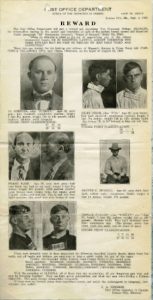 southwest Missouri. Spencer soon hopped a freight train bound for Oklahoma. Spencer found three other men to help him burglarize a store in Ochelata south of Bartlesville. They were surprised by the town’s night marshal who was shot and killed before the outlaws fled in a car. On June 16, Spencer and another man robbed the Elgin State Bank in Chautauqua County, Kansas. They fled with about $2,000 in cash and $20,000 in bonds.
southwest Missouri. Spencer soon hopped a freight train bound for Oklahoma. Spencer found three other men to help him burglarize a store in Ochelata south of Bartlesville. They were surprised by the town’s night marshal who was shot and killed before the outlaws fled in a car. On June 16, Spencer and another man robbed the Elgin State Bank in Chautauqua County, Kansas. They fled with about $2,000 in cash and $20,000 in bonds.
Exactly how many banks were robbed by Ethan Allen “Al” Spencer during the eighteen months following his escape is not known. Evidence suggests he probably robbed at least 20 banks in Oklahoma, Kansas, Missouri and Arkansas. The end of his crime spree came on a Saturday evening, September 15, 1923, when he was shot and killed. There is, however, debate on just how he was killed. U.S. Marshal Alva McDonald, a veteran lawman and personal friend of Teddy Roosevelt, claimed he and other lawmen shot Spencer just south of Caney, Kansas. Another account reported that Spencer was killed about five miles north of Coffeyville, Kansas. The third account came from outlaw Henry Wells’ autobiography. Wells claims that Stanley Snyder, a friend of Spencer’s, killed the outlaw with a shotgun while Spencer was eating supper. Some friend he must have been, but then I guess there is no honor among thieves. Al Spencer’s outlaw days were over, nevertheless, and a new breed of bad men soon took his place using only automobiles. Spencer was the last major Oklahoma outlaw to use horses in his crimes.
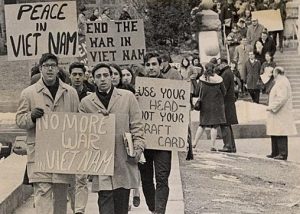 Registering for the draft is a requirement when a young man reaches 18 years of age. There is no draft in the United States anymore, but by registering the young men, the government could hold a draft, should a war bring such a need. During the Vietnam War, there were a lot of people who felt that the United States shouldn’t be in the war. Many young men didn’t want any part of it, and they decided to protest the war by burning their draft cards. Of course, this was forbidden by law, but they didn’t care. They were willing to take the chance, if it meant that they could avoid going to war.
Registering for the draft is a requirement when a young man reaches 18 years of age. There is no draft in the United States anymore, but by registering the young men, the government could hold a draft, should a war bring such a need. During the Vietnam War, there were a lot of people who felt that the United States shouldn’t be in the war. Many young men didn’t want any part of it, and they decided to protest the war by burning their draft cards. Of course, this was forbidden by law, but they didn’t care. They were willing to take the chance, if it meant that they could avoid going to war.
By May 1965 young men were protesting by burning their draft cards with greater frequency around the United States. To limit this kind of protest…in August 1965 the United States Congress enacted a law to broaden draft card violations to punish anyone who “knowingly destroys, knowingly mutilates” his draft card. Then, on October 15, 1965, in New York, David Miller, a young Catholic pacifist, became the first US war protestor to burn his draft card at a protest rally, in direct violation of a recently passed law forbidding such acts. Agents from the Federal Bureau of Investigation later arrested him. He was tried, found guilty, and sentenced to two years imprisonment, but that did not stop the protesting or the burning of draft cards. Subsequently, 46 men were indicted for burning their draft cards at various rallies, and four major court cases were heard. One of them, United States v. O’Brien, was argued before the Supreme Court. The act of draft card burning was defended as a symbolic form of free speech, a constitutional right guaranteed by the First Amendment. The Supreme Court decided against the draft card burners. It determined that the federal law was justified and that it was unrelated to the freedom of speech. This outcome was criticized by legal experts.
From 1965 to 1973, few men in the United States were convicted of burning their draft cards, and some 25,000 went unpunished. I suppose it was difficult to wrap our minds around the idea imprisonment for our young men over a protest. Still, it was illegal. And something had to be done. Before 1965, the act of burning a draft card was already prohibited by US statute and the registrant was required to carry the card at all times. Any destruction of the card was against the law. Also, it was entirely possible for a young man to destroy his draft card and still answer the call to service by appearing at an induction center and serving in the military. It also seems to me that if they had registered, that the government also had a copy of the registration, so if they were going to be drafted, having or not having the card was really a formality. And it was possible for a registrant to faithfully keep his card on his person but fail to appear when called. The draft 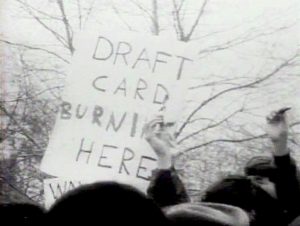 card burning was an act of protest against the war, more than it was a way to avoid the draft. Still, the image of draft card burning was powerful, and very influential in American politics and culture. Photos appeared in magazines, newspapers and on television. It was proof of a political divide between those who backed the United States government and its military goals and those who were against any United States involvement in Vietnam. With the political upheaval, Richard Nixon ran for president in 1968 on a platform based largely on putting an end to the draft, hoping to put an end to protesters burning their cards. As president, Nixon indeed did end the draft in 1973, rendering the symbolic act of draft card burning unnecessary, and registering just a requirement.
card burning was an act of protest against the war, more than it was a way to avoid the draft. Still, the image of draft card burning was powerful, and very influential in American politics and culture. Photos appeared in magazines, newspapers and on television. It was proof of a political divide between those who backed the United States government and its military goals and those who were against any United States involvement in Vietnam. With the political upheaval, Richard Nixon ran for president in 1968 on a platform based largely on putting an end to the draft, hoping to put an end to protesters burning their cards. As president, Nixon indeed did end the draft in 1973, rendering the symbolic act of draft card burning unnecessary, and registering just a requirement.
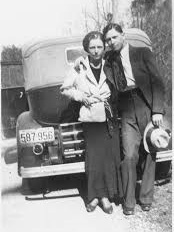
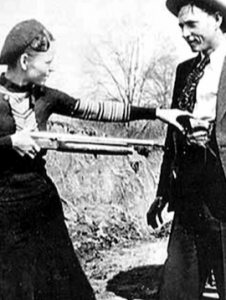 Most of the time, when we think of crime and criminals, we think of the worst evil there could be in a person, and I suppose that some criminals have more evil tendencies than others, but once in a while, someone decides to put a bit of a different twist on their crime…intending to romanticize it or give it a Robin Hood feel. In a large part, it is the media that truly romanticizes it or gives it notoriety. If the media didn’t report on every episode of the criminal’s life of crime, perhaps it would not seem so exciting to people, and maybe it wouldn’t inspire other criminals to…go for it. It all seems so exciting, at least that’s how the media plays it up.
Most of the time, when we think of crime and criminals, we think of the worst evil there could be in a person, and I suppose that some criminals have more evil tendencies than others, but once in a while, someone decides to put a bit of a different twist on their crime…intending to romanticize it or give it a Robin Hood feel. In a large part, it is the media that truly romanticizes it or gives it notoriety. If the media didn’t report on every episode of the criminal’s life of crime, perhaps it would not seem so exciting to people, and maybe it wouldn’t inspire other criminals to…go for it. It all seems so exciting, at least that’s how the media plays it up.
In reality, Bonnie and Clyde…notorious robbers and murders lived a very basic existence, and in many ways it was disgusting. Despite common popular culture depictions of Bonnie and Clyde, their life on the run was far from glamorous. They often ate sardines from the can, bathed in rivers, and drove through the night, taking shifts sleeping and driving, all in order to evade capture. They hid out in the forest, hoping not to be seen…always standing guard…always watching. Bonnie Parker met Clyde Barrow in Texas when she was 19 years old. Her husband, whom she married when she was 16, was serving time in jail for murder, and Clyde seemed exciting. Shortly after they met, Barrow was imprisoned for robbery. Bonnie visited Clyde every day, and smuggled a gun into prison to help him escape. He did escape, but was quickly recaptured in Ohio and sent back to jail. When Clyde was paroled in 1932, he immediately hooked up with Bonnie, and the couple began a life of crime together. Apparently Bonnie had a thing for bad boys…to her detriment, in the end.
The pair stole a car and committed several robberies, before Bonnie was caught by police and sent to jail for 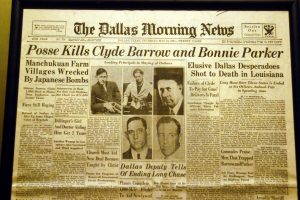 two months. Immediately after her release in mid-1932, she hooked up with Clyde again. Over the next two years, the couple teamed with various accomplices to rob a string of banks and stores across five states…Texas, Oklahoma, Missouri, New Mexico and Louisiana. To law enforcement agents, the Barrow Gang, including Clyde’s childhood friend, Raymond Hamilton, W.D. Jones, Henry Methvin, Barrow’s brother Buck and his wife Blanche, among others, were cold-blooded criminals who didn’t hesitate to kill anyone who got in their way, especially police or sheriff’s deputies. To the public, however, Bonnie and Clyde’s reputation as dangerous outlaws was mixed with a romantic view of the couple as “Robin Hood”-like folk heroes. Their fame was increased by the fact that Bonnie was a woman, which made her an unlikely criminal, and by the fact that the couple posed for playful photographs together, which were later found by police and released to the media. Police almost captured Bonnie and Clyde in the spring of 1933, with surprise raids on their hideouts in Joplin and Platte City, Missouri. Buck Barrow was killed in the second raid, and Blanche was arrested, but Bonnie and Clyde escaped once again. In January 1934, they attacked the Eastham Prison Farm in Texas to help Hamilton break out of jail, shooting several guards with machine guns…killing one.
two months. Immediately after her release in mid-1932, she hooked up with Clyde again. Over the next two years, the couple teamed with various accomplices to rob a string of banks and stores across five states…Texas, Oklahoma, Missouri, New Mexico and Louisiana. To law enforcement agents, the Barrow Gang, including Clyde’s childhood friend, Raymond Hamilton, W.D. Jones, Henry Methvin, Barrow’s brother Buck and his wife Blanche, among others, were cold-blooded criminals who didn’t hesitate to kill anyone who got in their way, especially police or sheriff’s deputies. To the public, however, Bonnie and Clyde’s reputation as dangerous outlaws was mixed with a romantic view of the couple as “Robin Hood”-like folk heroes. Their fame was increased by the fact that Bonnie was a woman, which made her an unlikely criminal, and by the fact that the couple posed for playful photographs together, which were later found by police and released to the media. Police almost captured Bonnie and Clyde in the spring of 1933, with surprise raids on their hideouts in Joplin and Platte City, Missouri. Buck Barrow was killed in the second raid, and Blanche was arrested, but Bonnie and Clyde escaped once again. In January 1934, they attacked the Eastham Prison Farm in Texas to help Hamilton break out of jail, shooting several guards with machine guns…killing one.
Texan prison officials hired Captain Frank Hamer, a retired Texas police officer, as a special investigator to track down Bonnie and Clyde. After a three month search, Hamer traced the couple to Louisiana, where Henry Methvin’s family lived. Bonnie and Clyde appeared, the officers opened fire, killing the couple instantly in a hail of 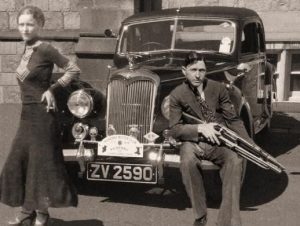
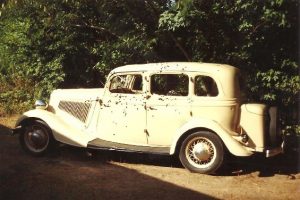 bullets. All told, the Barrow Gang was believed to have been responsible for the deaths of 13 people, including nine police officers. Bonnie and Clyde are still seen by many as romantic figures, however, especially after the success of the 1967 film Bonnie and Clyde, starring Faye Dunaway and Warren Beatty. It’s really a sad thing when crime is romanticized, because people think of it as an exciting, when in fact, it is a dead end road.
bullets. All told, the Barrow Gang was believed to have been responsible for the deaths of 13 people, including nine police officers. Bonnie and Clyde are still seen by many as romantic figures, however, especially after the success of the 1967 film Bonnie and Clyde, starring Faye Dunaway and Warren Beatty. It’s really a sad thing when crime is romanticized, because people think of it as an exciting, when in fact, it is a dead end road.
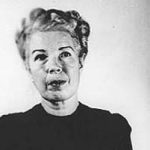 War is tough enough without having a traitor in the mix, and when a traitor is involved, things get even worse. One such traitor of World War II, was Mildred Gillars, aka Axis Sally. Apparently, Gillars, an American, was a opportunist. In 1940, she went to work as an announcer with the Reichs-Rundfunk-Gesellschaft (RRG), German State Radio. At the time, I suppose that she did nothing wrong…up to that point. In 1941, the US State Department was advising American nationals to return home, but Gillars chose to remain because her fiancé, Paul Karlson, a naturalized German citizen, said he would never marry her if she returned to the United States. Then, Karlson was sent to the Eastern Front, where he was killed in action. Gillars still did not return home.
War is tough enough without having a traitor in the mix, and when a traitor is involved, things get even worse. One such traitor of World War II, was Mildred Gillars, aka Axis Sally. Apparently, Gillars, an American, was a opportunist. In 1940, she went to work as an announcer with the Reichs-Rundfunk-Gesellschaft (RRG), German State Radio. At the time, I suppose that she did nothing wrong…up to that point. In 1941, the US State Department was advising American nationals to return home, but Gillars chose to remain because her fiancé, Paul Karlson, a naturalized German citizen, said he would never marry her if she returned to the United States. Then, Karlson was sent to the Eastern Front, where he was killed in action. Gillars still did not return home.
On December 7, 1941, Gillars was working in the studio when the Japanese attack on Pearl Harbor was announced. She broke down in front of her colleagues and denounced their allies in the east. “I told them what I thought about Japan and that the Germans would soon find out about them,” she recalled. “The shock was terrific. I lost all discretion.” This may have been the the last time she had any self respect. She later said that she knew that her outburst could send her to a concentration camp, so faced with the prospect of joblessness or prison, the frightened Gillars produced a written oath of allegiance to Germany and returned to work. She sold out. Her duties were initially limited to announcing records and participating in chat shows, but treason is a slippery slope. Gillars’ broadcasts initially were largely apolitical, but that changed in 1942, when Max Otto Koischwitz, the program director in the USA Zone at the RRG, cast Gillars in a new show called Home Sweet Home. She soon acquired several names amongst her GI audience, including the Berlin Bitch, Berlin Babe, Olga, and Sally, but the one most common was “Axis Sally”. This name probably came when asked on air to describe herself, Gillars had said she was “the Irish type… a real Sally.”
As her broadcasts progressed, Gillars began doing a show called Home Sweet Home Hour. This show ran from December 24, 1942, until 1945. It was a regular propaganda program, the purpose of which was to make US forces in Europe feel homesick. A running theme of these broadcasts was the infidelity of soldiers’ wives and sweethearts while the listeners were stationed in Europe and North Africa. I’m was designed to promote depression. I guess her aversion to the ways of the Japanese and Germans wasn’t so strong after all. She also did a show called Midge-at-the-Mike, which broadcast from March to late fall 1943. I this program, she played American songs interspersed with defeatist propaganda, anti-Semitic rhetoric and attacks on Franklin D. Roosevelt. And she did the GI’s Letter-box and Medical Reports 1944, which was directed at the US home audience. In this show, Gillars used information on wounded and captured US airmen to cause fear and worry in their families. After D-Day, June 6, 1944, US soldiers wounded and captured in France were also reported on. Gillars and Koischwitz worked for a time from Chartres and Paris for this purpose, visiting hospitals and interviewing POWs. In 1943 they had toured POW camps in Germany, interviewing captured Americans and recording their messages for their families in the US. The interviews were then edited for broadcast as though the speakers were well-treated or sympathetic to the Nazi cause. Gillars made her most notorious broadcast on June 5, 1944, just prior to the D-Day invasion of Normandy, France, in a radio play written by Koischwitz, Vision Of Invasion. She played Evelyn, an Ohio mother, who dreams that her son had died a horrific death on a ship in the English Channel during an attempted invasion of Occupied Europe.
After the war, Gillars mingled with the people of Germany, until her capture. Gillars was indicted on September 10, 1948, and charged with ten counts of treason, but only eight were proceeded with at her trial, which began  on January 25, 1949. The prosecution relied on the large number of her programs recorded by the FCC, stationed in Silver Hill, Maryland, to show her active participation in propaganda activities against the United States. It was also shown that she had taken an oath of allegiance to Hitler. The defense argued that her broadcasts stated unpopular opinions but did not amount to treasonable conduct. It was also argued that she was under the hypnotic influence of Koischwitz and therefore not fully responsible for her actions until after his death. On March 10, 1949, the jury convicted Gillars on just one count of treason, that of making the Vision Of Invasion broadcast. She was sentenced to 10 to 30 years in prison, and a $10,000 fine. In 1950, a federal appeals court upheld the sentence. She died June 25, 1988 at the age of 87.
on January 25, 1949. The prosecution relied on the large number of her programs recorded by the FCC, stationed in Silver Hill, Maryland, to show her active participation in propaganda activities against the United States. It was also shown that she had taken an oath of allegiance to Hitler. The defense argued that her broadcasts stated unpopular opinions but did not amount to treasonable conduct. It was also argued that she was under the hypnotic influence of Koischwitz and therefore not fully responsible for her actions until after his death. On March 10, 1949, the jury convicted Gillars on just one count of treason, that of making the Vision Of Invasion broadcast. She was sentenced to 10 to 30 years in prison, and a $10,000 fine. In 1950, a federal appeals court upheld the sentence. She died June 25, 1988 at the age of 87.
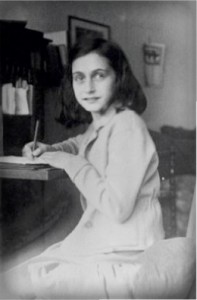 I am not related to Anne Frank, but her story is one that, while I cannot relate to personally, nevertheless touches me deeply. Anne, like another woman who I have long respected, Corrie ten Boom, went through some of the deepest forms of hatred there can possibly exist in this world. Anne was a Jewish girl, just turning 13 on this day, June 12, 1942, and Corrie ten Boom was a Dutch Christian woman who helped as many Jewish people as she could during the ugliness that was Hitler’s reign, and that would eventually take Anne’s life. The two women never met in person, to my knowledge, but while Anne may never have heard of Corrie, I’m certain that Corrie heard of Anne. The plight of the Jewish people touched Corrie ten Boom deeply too…deeply enough that she and her family risked their lives trying to hide the Jewish people from Hitler’s men, and act that eventually precipitated their capture and imprisonment, because it was against the law to help the Jewish people.
I am not related to Anne Frank, but her story is one that, while I cannot relate to personally, nevertheless touches me deeply. Anne, like another woman who I have long respected, Corrie ten Boom, went through some of the deepest forms of hatred there can possibly exist in this world. Anne was a Jewish girl, just turning 13 on this day, June 12, 1942, and Corrie ten Boom was a Dutch Christian woman who helped as many Jewish people as she could during the ugliness that was Hitler’s reign, and that would eventually take Anne’s life. The two women never met in person, to my knowledge, but while Anne may never have heard of Corrie, I’m certain that Corrie heard of Anne. The plight of the Jewish people touched Corrie ten Boom deeply too…deeply enough that she and her family risked their lives trying to hide the Jewish people from Hitler’s men, and act that eventually precipitated their capture and imprisonment, because it was against the law to help the Jewish people.
Hitler hated the Jewish people, and in reality, was probably afraid of them…hence his need to rid himself of them. Hitler was insane. During the time that Hitler was taking the Jewish people prisoner, and killing them, a young girl named Anne Frank was turning 13, and was given a diary for her birthday. Having been a young girl with a diary, I can relate to the excitement of getting a diary in which to record your deepest thoughts, hopes, dreams, and secrets. I can also say that at that time, I felt like my life was relatively boring, and so writing in my diary quickly became a chore, and was soon forgotten. I have to wonder if Anne’s diary might have suffered the same fate…had things been different. Most kids get pretty bored with writing down their thoughts everyday, but Anne’s life was about to change forever. She was about to spend the next two years in hiding in a secret room in her father’s office, along with four other families, dependent on loving Christians for their every need.
The Nazis were coming, and they were determined to kill every Jewish person they could. Anne and her family had to go into hiding. And so it was, that a young girl trapped behind a wall that led to a secret room, where silence was essential for survival, began to write down her thoughts and experiences in what would become the most read diary in history. Anne would not live to become an adult, to marry, or to have children, and yet, she would go on to become one of the most well known children in history. My great aunt, Bertha Schumacher Hallgren said that anyone could become a famous writer, if they just wrote about the events of their life, and colored it with some information about the time in history in which they lived. That is exactly what Anne Frank 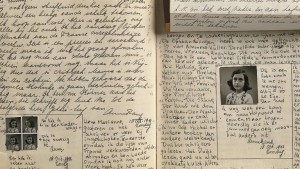 did. I have to think that she assumed that no one would care about her little life spent in hiding, much less about how a 13 year old girl felt about it, but after she died of Typhus in a prison camp called Bergen-Belsen, just one month before the end of the war, they did care. The Christian friends found her diary after their capture, and kept it in the hope of giving it back to her. Her father lived through that horrible time, and the diary was returned to him. He had it published in her honor in 1947. The book was called “The Diary of a Young Girl,” and has been made into a movie too, because in the end, it told the world about a very ugly time in history.
did. I have to think that she assumed that no one would care about her little life spent in hiding, much less about how a 13 year old girl felt about it, but after she died of Typhus in a prison camp called Bergen-Belsen, just one month before the end of the war, they did care. The Christian friends found her diary after their capture, and kept it in the hope of giving it back to her. Her father lived through that horrible time, and the diary was returned to him. He had it published in her honor in 1947. The book was called “The Diary of a Young Girl,” and has been made into a movie too, because in the end, it told the world about a very ugly time in history.

